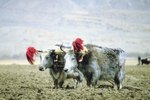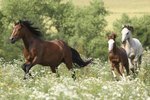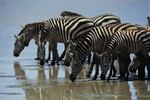
Fossil records of eastern Russia indicate yaks lived in that region thousands of years ago, leading paleontologists to believe that yak-like ancestors of the American bison crossed over the Siberian land bridge and migrated to North America. Both are bovines belonging to the scientific family bovidae. But that is where the classification similarities end. Yaks are of the Bos genus. Bison are their own genus.
Yaks Live in Asia
The Tibetan plateau -- a high-altitude arid steppe four times the size of France in Central Asia, with parts of China, Nepal and Tibet within in its borders -- is home for yaks. While some of the plateau itself is flat, it's surrounded by large mountain ranges such as the Himalayas to the south and the Kunlun Range to the north. Its average elevation is 14,800 feet above sea level where herds of wild yaks are frequently found. Domesticated yaks used for transport and agricultural purposes live with their human caretakers on the plateau. Yaks are also found in mountainous regions of Mongolia and Russia.
Bison Live in North America and Europe
Centuries ago, American bison lived on the central plains of North America extending from the Gulf of Mexico in the United States to the plains of interior Canada. Today, small wild herds live in national parks such as Yellowstone in Wyoming, the National Bison Range in Montana and Wood Buffalo National Park in Canada's Northwest Territory. Domesticated bison are kept for meat production in the U.S. and Canada. Wild European bison were hunted to extinction between 1919 and 1927. Efforts to reintroduce offspring from bison held in zoos to forests in eastern Europe have met with limited success, and the species is still considered endangered.
Killed for Sport
The very existence of both yaks and bison is threatened by sport hunters. As American settlers moved westward, large roaming herds of bison were viewed as easy targets. While a small portion of this hunting was for food, the bulk of it was unbridled sport hunting encouraged by the U.S. government as a way to starve out native peoples not willing to give up their territory. Hunting from the comfort of moving trains, sportsmen left tens of thousands of carcasses to rot on the plains. What was once estimated to be herds totaling 50 million bison roaming the North American plain dwindled to fewer than 1,000 before conservation efforts were put in place.
Wild yak herds were nearly decimated by Chinese hunters also not adhering to "take only what you need" principles. In January 2013, an American and Chinese conservation research team visited the remote Hoh Xil nature reserve, which is about the size of West Virginia, and counted nearly 1,000 wild yaks, giving hope that the population is rebounding.
Friendly Factor
Domesticated yaks and humans enjoy a much friendlier relationship than exists between humans and domesticated bison. Domesticated yaks are relatively docile -- especially when raised by humans from birth. They are easy to train for pulling carts and plows and are often treated in the same way Europeans and Americans handle horses. Domesticated bison are not as far removed from their wild personalities, however. Bison can be trained to respond to captive conditions as beef cattle do -- eating from feeders, being herded through lots and pens. However, they retain the bulk of their natural tendencies -- especially the fight or flight instinct -- and are highly unpredictable.
Physical Characteristics
In general, bison are larger than yaks. Sexually mature male bison weigh anywhere from 1,100 to 2,000 pounds, depending on age. Females weigh 700 to 1,200 pounds. Sexually mature male yaks weigh 650 to 800 pounds; the females weigh 400 to 700 pounds. Bison have dark brown hair that can appear black from a distance, especially in the winter when the thicker undercoat is in place. Domesticated yaks vary in color from light tan to dark brown as well as black, which is the dominant color seen in wild herds. A yak's tail is long and very thick with silky hair similar to that of a horse. In contrast, a bison has a short, stubby tail that most generally sticks out in a position horizontal to its body.
References
- Hobby Farms: Yaks And Water Buffalo: Alternative Bovines
- Worldwatch Institute: Yaks: The Bison Of The Mountains
- Wykle Yak Ranch: Yaks: The Bison Of Tibet
- New York Times: Science: Yaks Make A Comeback
- Wildlife Conservation Society: Yaks Are Back
- A-Z Animals: Yak
- A-Z Animals: Bison
- PBS: The Great American Bison
- Canisius Ambassadors For Conservation: Bison
- Bison Producers Of Alberta: How Do I Raise A Pet Bison?
Photo Credits
-
David De Lossy/Digital Vision/Getty Images
Writer Bio
Amy M. Armstrong is a former community news journalist with more than 15 years of experience writing features and covering school districts. She has received more than 40 awards for excellence in journalism and photography. She holds a Bachelor of Arts in communications from Washington State University. Armstrong grew up on a dairy farm in western Washington and wrote agricultural news while in college.



